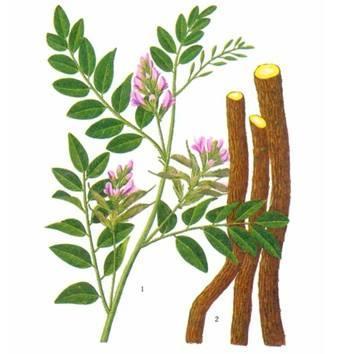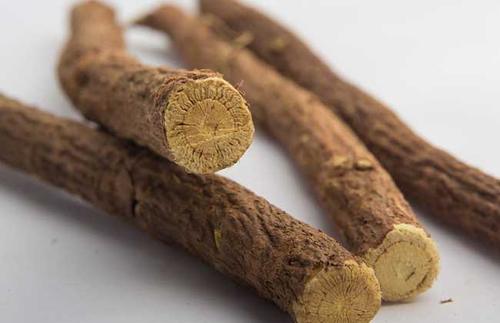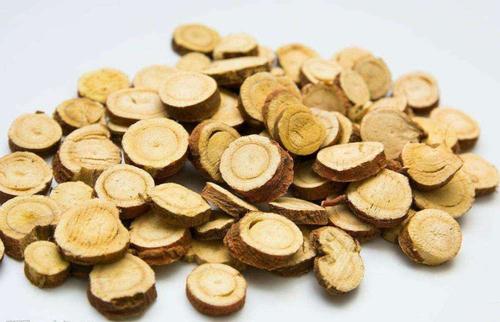Glycyrrhiza uralensis Fisch Profile
Written by Lisa
Nov 09 2020

Glycyrrhiza uralensis Fisch is a perennial herb with strong roots and rhizomes. It is mostly used as medicine. It is a tonic Chinese herbal medicine. The roots of the medicinal materials are cylindrical.
Glycyrrhiza uralensis Fisch Picture

Glycyrrhiza uralensis Fisch is sweet and special. The function of glycyrrhiza uralensis fisch is mainly to clear away heat and detoxify, expectorant and relieve cough, and abdominal abdomen. Glycyrrhiza uralensis likes a dark, humid, dry climate with long sunshine and low temperature. Glycyrrhiza uralensis Fisch grows mostly in arid and semi-arid desert grasslands, desert edges and loess hilly areas.
Glycyrrhiza uralensis Fisch Morphological characteristics
Glycyrrhiza uralensis Fisch is a perennial herb with thick roots and rhizomes. Its root is 1-3 cm in diameter with brown skin and light yellow inside. It taste sweet.
The stem is upright, multi-branched, 30-120 cm high, densely covered with scaly glands, spiny glands and white or brown hairs.
The leaves are 5-20 cm long, stipules are triangular-lanceolate, about 5 mm long and 2 mm wide, densely covered with white pubescent on both sides; petioles densely covered with brown glands and pubescent; leaflets 5-17, Oval, long oval or nearly round, 1.5-5 cm long, 0.8-3 cm wide, dark green on the top, green on the bottom, densely covered with yellowish brown glands and pubescent on both sides, blunt top, short pointed, The base is round, the edges are all or slightly wavy, and somewhat recurved.

The raceme is axillary, with many flowers, the total pedicel is shorter than the leaves, densely brown scale-like glands and pubescent; the corolla is purple, white or yellow, 10-24 mm long, the flag petals are oblong, and the top is slightly concave, The base has a short stem. The pods are curved sickle-shaped or ring-shaped, densely packed into balls, densely tumor-like protrusions and thorny glands. Seeds 3-11, dark green, round or kidney-shaped, about 3 mm long. Flowering period from June to August, fruiting period from July to October.
Glycyrrhiza uralensis Fisch Growth environment and distribution
Licorice has strong adaptability and stress resistance. It grows in arid and semi-arid sandy soil, desert edges and loess hilly areas
Naturally, it likes an ecological environment with sufficient sunlight, less rainfall, hot summer, severe cold in winter, and large temperature difference between day and night, and has the characteristics of light, drought, heat, salt and alkali and cold. It is suitable for growing in sandy soil with deep soil, loose soil and good drainage.
It is distributed in Asia, Europe, Australia, America and other places (and most of them have traditional medicinal and other uses).
Licorice in China is mainly distributed in Xinjiang, Inner Mongolia, Ningxia, Gansu, and Shuozhou of Shanxi. Artificially planted licorice is mainly produced in the Hexi Corridor of Xinjiang, Inner Mongolia, Gansu, the periphery of Longxi, and parts of Ningxia.
Reproduction of Glycyrrhiza uralensis Fisch
Glycyrrhiza uralensis Fisch reproduction is divided into sexual reproduction and asexual reproduction (fast growth).
Seed propagation: Soak the seeds in 60℃ warm water for 4-6 hours, remove the seeds and place them in a warm place, cover them with a damp cloth, and drench them with clean water twice a day to sprout.

Main value of Glycyrrhiza uralensis Fisch
Medicinal value
Glycyrrhiza uralensis Fisch is the most commonly used clinical medicine. Raw licorice can clear away heat and detoxify, moisturize the lungs and relieve cough, and reconcile the properties of various medicines. Roasted licorice can nourish the spleen and nourish qi, with a large clinical dosage and a large export volume. In addition to medicinal use, Glycyrrhiza uralensis Fisch is also used as a pastry additive in a large number of foods, and its sweetness is a hundred times that of sucrose. Western countries import licorice in large quantities and extract glycyrrhetinic acid from it to cure AIDS. Returning licorice from farmland to forests has a stronger effect on soil and water conservation.
Nutritional value
1. Glycyrrhiza uralensis Fisch has similar effects as adrenal cortex hormones. It has an inhibitory effect on the excessive secretion of gastric acid caused by histamine; and has an anti-acid effect and relieves gastrointestinal smooth muscle spasm.
2. Glycyrrhiza uralensis Fisch flavonoids, licorice extract and glycyrrhetinic acid all have obvious antitussive effects; the expectorant effect is also significant
3. Glycyrrhiza uralensis Fisch also has anti-inflammatory and anti-allergic effects and can protect the inflamed throat and tracheal mucosa. Licorice extract and glycyrrhizic acid have detoxification effects similar to glucuronic acid for certain poisons.
4. Glycyrrhiza uralensis Fisch is often used to treat the symptoms that come with menopause. Because licorice contains glycyrrhizin, which is a hormone-like compound, it helps balance the hormone content in women.
5. The hypoacid contained in Glycyrrhiza uralensis Fisch can block the effect of carcinogens in inducing tumor growth.
Latest Updated
- Benefits of Bugleweed - 7 Science-backed Health Benefits
- Bugleweed Dangers & Side Effects - Is It Poisonous?
- How to Plant Evergreen Trees - What You Should Know
- When to Plant Evergreens - Grow Guide for Evergreen Trees
- 12 Wonderful Evergreen Shrubs for Your Garden
- 12 Popular Evergreen Plants with Pictures for Beginners
- When And How To Prune A Lilac Bush Like a Pro
- How to Grow & Care for Lilac Vine (Hardenbergia Violacea)
- Japanese Lilac Tree (Syringa Reticulata) Care & Propagation Guide
- Shumard Oak Pros and Cons - What to Know
Popular Articles
- Winter maintenance of Antirrhinum Majus
- How to Grow Terminalia Mantaly Tree
- How to Grow and Care for Crossostephium Chinense
- How to grow Antirrhinum Majus in spring
- Peristeria Elata (Dove Orchid) Profile: Info & Care Guide
- Underwatered Snake Plant (Sansevieria Trifasciata) - Signs And How To Fix
- How to Care for Brazilian Jasmine Plant (Mandevilla Sanderi)
- How to Grow & Care for Graptopetalum Purple Delight in Summer
- Rosa Chinensis (China Rose): Plant Growing & Care Tips
- How to Care for Baby Sun Rose (Aptenia Cordifolia)